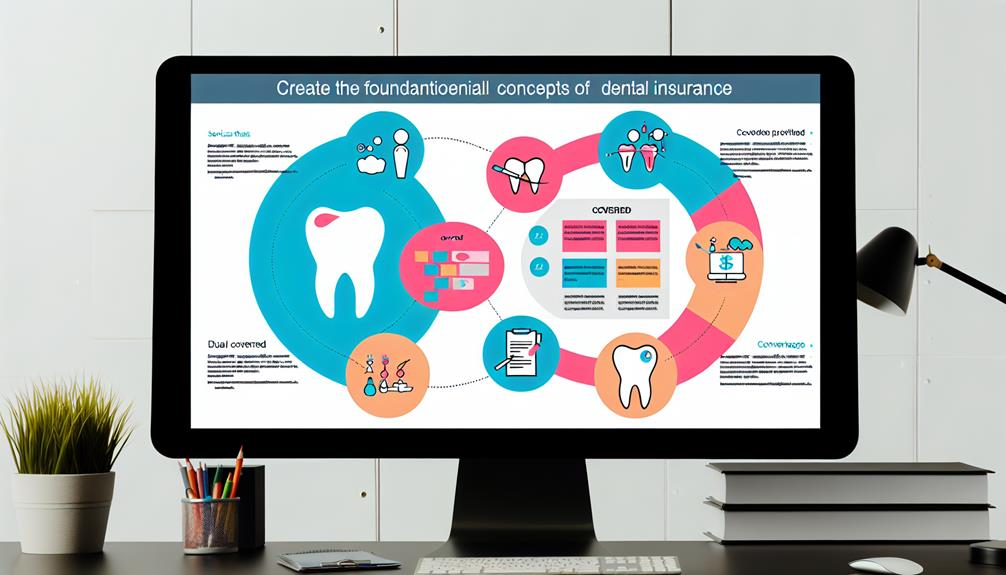Dental insurance offers coverage for a range of oral healthcare services, primarily focusing on preventive care like routine check-ups and cleanings. Basic services, such as fillings and extractions, may also be included, but coverage can vary greatly. Major services, including crowns and implants, typically have lower reimbursement rates. It's important to understand deductibles and co-pays, as they impact out-of-pocket costs. Additionally, plans may impose exclusions and waiting periods. Selecting the right plan involves evaluating personal dental needs and comparing coverage features. Exploring these details can enhance your understanding of dental insurance and its benefits.
Key Takeaways
- Dental insurance typically covers preventive services like check-ups and cleanings at high percentages to promote oral health.
- Basic restorative procedures, such as fillings and crowns, have varying coverage levels depending on the plan.
- Major services, including dental implants and orthodontics, often have lower coverage percentages and may require out-of-pocket expenses.
- Policies may have exclusions, waiting periods, and annual limits affecting coverage for specific treatments and conditions.
- Understanding deductibles and co-pays is essential for managing overall dental care costs and maximizing insurance benefits.
Understanding Dental Insurance Basics

Dental insurance serves as an essential financial tool that helps individuals manage the costs associated with oral healthcare. Understanding the basics of dental insurance is vital for making informed decisions about coverage. At its core, dental insurance typically includes various plans that differ in relation to coverage terminology, such as deductibles, copayments, and annual maximums. Navigating the emotional journey of choosing the right plan can be just as important as understanding the policy details, as it can greatly impact your well-being during this process navigating emotional challenges.
When evaluating dental insurance options, it is beneficial to conduct policy comparisons to identify which plan best meets your needs and budget. Some policies may emphasize preventive care, offering full coverage for routine check-ups and cleanings, while others may provide more extensive coverage that includes restorative procedures, such as fillings and crowns.
Additionally, understanding terms like in-network and out-of-network providers can greatly affect out-of-pocket expenses. By familiarizing yourself with these concepts, you can better navigate the complexities of dental insurance. Ultimately, possessing a solid grasp of dental insurance basics empowers individuals and families to secure the oral healthcare they require while minimizing financial burdens. This knowledge fosters a sense of belonging within the broader community that values accessible and effective dental care.
Common Coverage Areas
While individuals may have varying needs for oral healthcare, common coverage areas in dental insurance typically include preventive, basic, and major services. Understanding these areas can help you make informed decisions regarding your dental care and insurance premiums. Additionally, maintaining good oral health can also contribute positively to your overall well-being and stress levels, as poor dental health can lead to increased anxiety and discomfort, which in turn may affect your immune system how stress affects health.
- Preventive Services: These are essential for maintaining oral health and often include routine check-ups, cleanings, and X-rays. Insurance generally covers these services at a high percentage, making them accessible to most policyholders.
- Basic Services: This category encompasses procedures such as fillings, extractions, and certain periodontal treatments. While these services are necessary for addressing common dental issues, coverage may vary, often requiring a copayment or deductible.
- Major Services: These include more complex procedures like crowns, bridges, and dentures. Typically, insurance premiums will cover a lower percentage of these costs, reflecting the higher expense associated with major dental work.
Being aware of these common coverage areas can empower you to navigate your dental insurance effectively, ensuring you receive the best possible care while managing your financial responsibilities.
Preventive Services

A significant component of any dental insurance plan, preventive services play an important role in maintaining oral health and preventing more serious dental issues down the line. These services are designed to promote dental hygiene and educate patients about effective oral care practices, similar to how small acts of kindness can foster positive connections and improve overall well-being.
Routine checkups typically include thorough oral examinations, during which dentists assess the condition of teeth and gums, identifying any potential problems early. X-ray assessments may also be conducted, allowing for a complete evaluation of hidden dental structures.
In addition to examinations, preventive care often encompasses fluoride treatments, which help strengthen tooth enamel and reduce the risk of cavities, particularly in children. Sealant application is another crucial service, providing a protective coating on the chewing surfaces of back teeth to prevent decay.
Basic Restorative Procedures
Basic restorative procedures are vital for addressing dental issues that arise despite preventive care efforts. These treatments help restore the function and aesthetics of teeth that may be damaged due to decay, trauma, or wear. Understanding your options can empower you to make informed decisions about your dental health. Additionally, similar to how certain medications can affect overall well-being, the choice of restorative procedure can markedly impact your long-term dental health and comfort in daily activities mood disorders and sleep disturbances.
Here are three primary types of basic restorative procedures:
- Fillings: Various fillings types, including composite resin, amalgam, and glass ionomer, are used to treat cavities. The choice often depends on the location of the cavity and your aesthetic preferences.
- Crowns: When a tooth is severely damaged, a crown may be necessary to provide strength and protection. Crown materials include porcelain, metal, and ceramic, each offering distinct advantages in durability and appearance.
- Bridges: An effective solution for replacing missing teeth, bridges utilize adjacent teeth for support, restoring both function and smile aesthetics.
Insurance coverage for these restorative procedures can vary, so it's important to understand your plan. Discussing these options with your dentist can guarantee you receive the best care tailored to your needs.
Major Dental Services

Major dental services are frequently vital for addressing more complex oral health issues that cannot be resolved through basic restorative procedures. These services not only restore functionality but also enhance the aesthetics of one's smile, making them significant in both health and cosmetic dentistry sectors.
| Service | Description |
|---|---|
| Dental Implants | Permanent replacements for missing teeth, providing both functionality and aesthetic appeal. |
| Crowns | Caps placed over damaged teeth to restore shape, size, and strength. |
| Bridges | Prosthetic devices used to replace one or more missing teeth, anchored to neighboring teeth. |
| Orthodontics | Treatments designed to correct misaligned teeth and jaws, improving both function and appearance. |
These major dental services can be transformative, offering solutions that promote long-term dental health. Additionally, insurance coverage for these procedures varies widely, making it important for individuals to understand their specific plans. By being informed, patients can make empowered decisions that align with their health goals and financial capabilities. Ultimately, embracing these services can lead to improved oral health and enhanced self-confidence.
Exclusions and Limitations
Understanding the exclusions and limitations of dental insurance is vital for maximizing coverage and minimizing out-of-pocket expenses. Just like with mental health medications, where understanding who is qualified to prescribe can influence treatment choices, familiarizing yourself with dental insurance factors can help you make informed decisions regarding your dental care. Here are three important aspects to take into account:
- Pre-existing Conditions: Many policies do not cover treatment for dental issues that existed before the insurance was obtained.
- Waiting Periods: Some plans impose waiting periods before certain services, particularly major treatments, are eligible for coverage.
- Annual Limits: Most dental insurance plans have annual limits on what they will pay, which can lead to significant out-of-pocket costs once you exceed that threshold.
Additionally, be aware of out-of-network penalties that can arise if you seek care outside your provider network. Coverage tiers often dictate the extent of benefits for various services, with emergency services sometimes being prioritized over cosmetic procedures. Finally, understanding the claim processes is vital to guarantee that you are reimbursed appropriately for the services you receive. By grasping these exclusions and limitations, you can better navigate your dental insurance plan and secure the care you need.
Orthodontic Coverage

Orthodontic coverage is a significant component of many dental insurance plans, as it addresses the financial aspects of necessary treatments aimed at correcting misaligned teeth and jaw issues. This coverage typically includes various orthodontic treatments, most importantly braces, which are designed to improve dental alignment and overall oral health.
When evaluating dental insurance options, it is essential to understand the specifics of braces coverage. Some plans may offer thorough benefits for both children and adults, while others may impose age limits or coverage caps. Additionally, orthodontic treatment may involve multiple phases, such as initial evaluations, appliance placements, and ongoing adjustments, all of which should be considered when reviewing total coverage.
Many insurance providers require a waiting period before orthodontic benefits become effective, highlighting the importance of planning ahead. Moreover, not all treatments may be covered; for instance, cosmetic enhancements might not qualify under standard orthodontic coverage.
As you navigate your dental insurance options, make sure you inquire about the specifics of orthodontic coverage. Understanding these details will empower you to make informed decisions for yourself and your family, fostering a sense of belonging within the community of individuals seeking improved oral health.
Understanding Deductibles and Co-pays
When selecting a dental insurance plan, it is essential to take into account not only the coverage for treatments like orthodontics but also the associated costs, specifically deductibles and co-pays. Understanding these financial components can greatly impact your overall expenses.
- Deductible Definitions: A deductible is the amount you must pay out-of-pocket before your insurance begins to cover treatment costs. Each plan has its own deductible limit, so it's important to know this figure to budget accordingly.
- Co-pay Calculations: A co-pay is a fixed amount you pay for specific dental services at the time of your appointment. This can vary by service type, and understanding these amounts helps in planning for routine visits.
- Impact on Overall Costs: Both deductibles and co-pays contribute to your total expenditure. By knowing your plan's specific deductible definitions and co-pay calculations, you can make more informed decisions about your dental care and budget effectively.
Awareness of these factors allows you to maximize your dental insurance benefits while minimizing unexpected costs.
Tips for Maximizing Benefits

Maximizing the benefits of your dental insurance requires strategic planning and informed decision-making. To begin, it is essential to familiarize yourself with your plan's coverage limits, including annual maximums and specific procedures covered. Knowing these details will enable you to prioritize your dental health needs effectively.
Next, consider scheduling preventive care visits, such as cleanings and exams, as these are often fully covered and can prevent more costly procedures down the line. Utilize your insurance for necessary treatments promptly, ensuring you stay within your plan's coverage period.
Incorporate financial planning into your dental care strategy by setting aside funds for out-of-pocket expenses. This proactive approach can alleviate the financial burden of unexpected dental work, allowing you to take full advantage of your benefits.
Choosing the Right Plan
Selecting an appropriate dental insurance plan is a fundamental step in safeguarding your oral health while managing costs. With numerous options available, understanding key aspects can greatly influence your choice. Here are three critical factors to take into account during your plan comparison:
- Coverage and Policy Features: Examine what services are included. Does the plan cover preventive care, basic procedures, and major work? Verify it aligns with your dental needs.
- Network of Providers: Check if your current dentist is in-network, as this can affect out-of-pocket expenses. A broad network may provide more choices, increasing convenience and satisfaction.
- Cost Structure: Analyze premiums, deductibles, and co-pays. A lower premium might seem attractive, but higher out-of-pocket costs could lead to unexpected expenses.
Frequently Asked Questions
How Do Waiting Periods Affect Dental Coverage?
Waiting periods considerably impact dental coverage by imposing restrictions on when policyholders can access certain benefits. These waiting period implications can lead to coverage limitations for essential treatments, such as major procedures or orthodontics, which may require a waiting period of several months. Consequently, individuals may find themselves financially burdened if urgent dental care is needed before their coverage becomes effective, highlighting the importance of understanding these terms before selecting a dental insurance plan.
Can I Use Dental Insurance for Cosmetic Procedures?
Cosmetic dentistry often enhances the aesthetic appearance of teeth, but coverage under insurance policies is typically limited. Most dental insurance plans prioritize essential treatments, such as preventive and restorative care, over elective procedures. Consequently, procedures like teeth whitening, veneers, and cosmetic bonding frequently fall outside the scope of coverage. It's critical for individuals to review their specific insurance policy details to understand the extent of coverage for cosmetic dentistry.
What Happens if I Miss a Dental Appointment?
Missing a dental appointment can lead to various repercussions, including the potential for rescheduling challenges and the disruption of ongoing treatment plans. Many dental practices provide appointment reminders to help minimize such occurrences. If you miss an appointment, it is advisable to contact the office promptly to discuss rescheduling options. Addressing missed appointments expediently not only fosters strong communication with your dental provider but also supports your overall oral health maintenance.
Are There Age Limits for Dental Insurance Coverage?
Dental insurance coverage may indeed have age-based restrictions, varying considerably among different plans. Typically, children may receive more extensive benefits, particularly for preventive care, while adult coverage might focus on restorative procedures. Seniors may encounter additional limitations or specialized plans tailored to their needs. It is essential for individuals to carefully review their policy details, as coverage variations can impact access to necessary dental services across different life stages.
Does Dental Insurance Cover Out-Of-Network Providers?
Dental insurance coverage for out-of-network providers varies greatly among plans. Typically, in-network benefits offer higher reimbursement rates, resulting in lower out-of-pocket costs for policyholders. When using out-of-network providers, individuals may face cost differences due to decreased coverage levels and higher deductibles. It's crucial for policyholders to review their specific plan details to understand the implications of seeking care from non-participating providers and to guarantee they can manage potential additional expenses.





